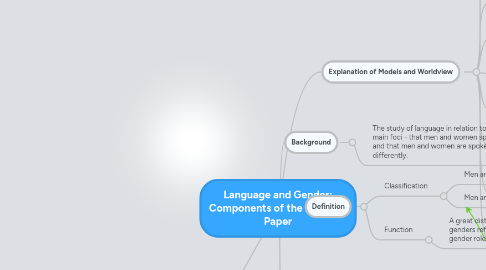
1. Context
1.1. Relevance to Domain
1.1.1. The way language varies based on gender demonstrates the ways in which males and females are stereotyped within the culture
1.2. Purpose
1.2.1. To increase awareness on how language and gender are connected.
2. Background
2.1. The study of language in relation to gender has two main foci - that men and women speak differently, and that men and women are spoken about differently.
3. Definition
3.1. Classification
3.1.1. Men and women speak differently
3.1.2. Men and women are spoken about differently
3.2. Function
3.2.1. A great distinction in use of language between genders reflects societies with strictly defined gender roles
4. Exemplification
4.1. In syntax and pronunciation, females are more sensitive to linguistic norms than males.
4.1.1. Trudgill's self-evaluation test
4.1.2. Elyan et al.'s Lancashire study
4.1.3. Milroy's comparative study of Ballymacarrett, and the Clonard and the Hammer
4.2. Men and women have different communication strategies
4.3. Use of "man" and the male pronouns as generics
4.3.1. Because it is a widely-known ancient rule of English grammar, it is justified.
4.3.2. However, the evidence appears to suggest that the terms in question are false generics.
4.3.2.1. Studies of Schneider and Hucker
4.3.2.2. Stanley
4.3.2.2.1. counted the words for sexually promiscuous females and males
5. Explanation of Models and Worldview
5.1. Trudgill Norwich, Labov, Coates
5.1.1. Female speakers tend to use more prestige forms than males.
5.2. Milroy
5.2.1. Group solidarity is more influential in activating group speech patterns than the desire to achieve a certain norm.
5.3. Zimmerman and West
5.3.1. Men tend to interrupt very frequently and are slow to provide supporting responses to women's speech turns.
5.4. Lakoff and Holmes
5.4.1. Women help a conversation to move along smoothly.
5.5. Bernard, Swacker, Eakins (1975), and Eakins (1978)
5.5.1. Men generally talk more than women
5.6. Spender
5.6.1. It seems that women speak more than men because men are expected by the culture in general to talk, therefore it is more noticeable if women talk.
5.7. Schneider and Hucker
5.8. Stanley
5.8.1. Language has only a negative semantic space for women.
5.8.2. Behavioral standards required of a "lady" are reflected in linguistic usage
